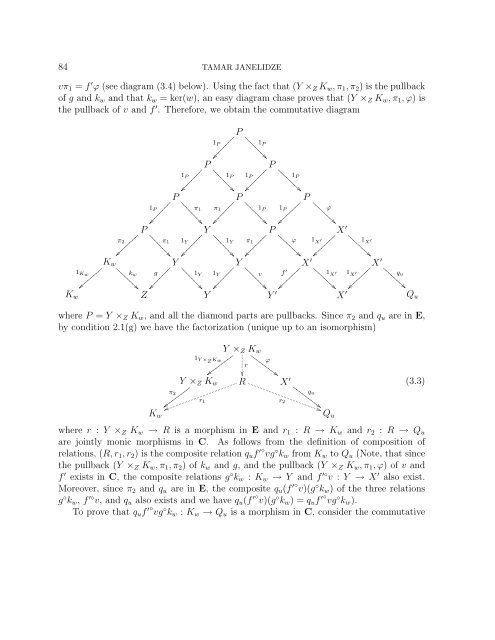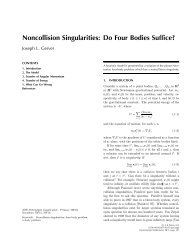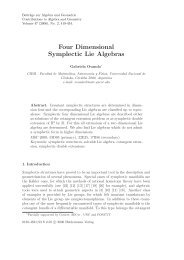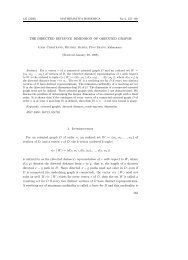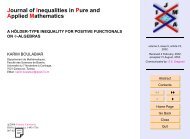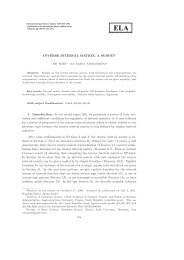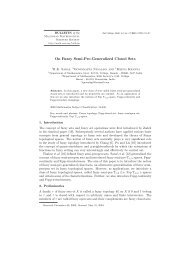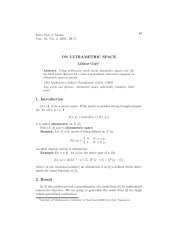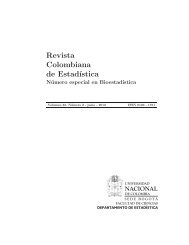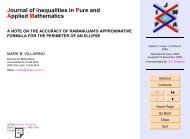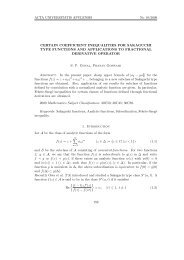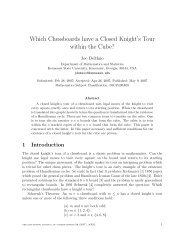SNAKE LEMMA IN INCOMPLETE RELATIVE HOMOLOGICAL ...
SNAKE LEMMA IN INCOMPLETE RELATIVE HOMOLOGICAL ...
SNAKE LEMMA IN INCOMPLETE RELATIVE HOMOLOGICAL ...
You also want an ePaper? Increase the reach of your titles
YUMPU automatically turns print PDFs into web optimized ePapers that Google loves.
84 TAMAR JANELIDZE<br />
vπ 1 = f ′ ϕ (see diagram (3.4) below). Using the fact that (Y × Z K w , π 1 , π 2 ) is the pullback<br />
of g and k w and that k w = ker(w), an easy diagram chase proves that (Y × Z K w , π 1 , ϕ) is<br />
the pullback of v and f ′ . Therefore, we obtain the commutative diagram<br />
<br />
1 P<br />
1 P<br />
<br />
P <br />
P<br />
1 P 1 P 1 P<br />
<br />
P <br />
P<br />
<br />
1 P <br />
π 1 π 1 1 P<br />
<br />
P<br />
Y<br />
P<br />
P<br />
<br />
1 P<br />
<br />
<br />
<br />
<br />
π 2 <br />
X ′<br />
π 1 1 Y <br />
<br />
1 Y π 1 ϕ 1 X ′<br />
<br />
1 X ′<br />
<br />
<br />
K w <br />
Y<br />
1 <br />
Y<br />
Kw <br />
X ′<br />
k w g <br />
X ′<br />
1 Y 1 Y <br />
<br />
v f ′ 1 X ′ 1 <br />
X ′<br />
q u<br />
<br />
<br />
K w Z Y Y ′ X ′ Q u<br />
1 P<br />
P<br />
<br />
ϕ<br />
where P = Y × Z K w , and all the diamond parts are pullbacks. Since π 2 and q u are in E,<br />
by condition 2.1(g) we have the factorization (unique up to an isomorphism)<br />
1 Y ×Z Kw<br />
<br />
Y × Z K w<br />
Y × Z K w <br />
r<br />
ϕ<br />
R X ′ (3.3)<br />
<br />
π 2<br />
q u<br />
r 1<br />
r 2<br />
<br />
K w Q u<br />
where r : Y × Z K w → R is a morphism in E and r 1 : R → K w and r 2 : R → Q u<br />
are jointly monic morphisms in C. As follows from the definition of composition of<br />
relations, (R, r 1 , r 2 ) is the composite relation q u f ′◦ vg ◦ k w from K w to Q u (Note, that since<br />
the pullback (Y × Z K w , π 1 , π 2 ) of k w and g, and the pullback (Y × Z K w , π 1 , ϕ) of v and<br />
f ′ exists in C, the composite relations g ◦ k w : K w → Y and f ′◦ v : Y → X ′ also exist.<br />
Moreover, since π 2 and q u are in E, the composite q u (f ′◦ v)(g ◦ k w ) of the three relations<br />
g ◦ k w , f ′◦ v, and q u also exists and we have q u (f ′◦ v)(g ◦ k w ) = q u f ′◦ vg ◦ k w ).<br />
To prove that q u f ′◦ vg ◦ k w : K w → Q u is a morphism in C, consider the commutative


